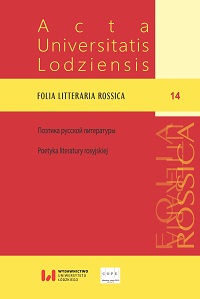Стихотворение Николая Гумилева «Неслышный, мелкий падал дождь…»: мотив двойничества и постижение природы зла
DOI:
https://doi.org/10.18778/1427-9681.14.08Słowa kluczowe:
Н. Гумилев, двойничество, дихотомия добра и зла, лирический герой, лирический нарратив, символизмAbstrakt
В статье рассматривается поэтика малоизвестного стихотворения Н. Гумилева «Неслышный, мелкий падал дождь…» (1907) в аспекте становления мотива двойничества как ключевого параметра гумилевского художественного мира. В основе данного поэтиче- ского текста находится нарративная репрезентация встречи лирического героя с персонажем- убийцей, предстающим в качестве двойнической ипостаси субъектного «я». Анализ стихот- ворения показывает, что ценностное узнавание страдальческого бытия демонического пришельца оказывается актом постижения онтологической природы зла, которое в созна- нии лирического героя обретает статус равновесной добру бытийной константы. Формули- руется вывод о том, что познание инфернальной стороны универсума посредством актуали- зации мотива двойничества в гумилевском творчестве мыслится необходимым процессом обретения духовного опыта, синтезирующего «светлые» (положительные) и «темные» (от- рицательные) аспекта бытия. Соответственно, представленное в данном тексте соприкос- новение лирического «я» с преступно-демоническим двойником демонстрирует принципы формирования окказиональной мифопоэтики Н. Гумилева, основанной на конвергенции онтологических антиномий.
Pobrania
Bibliografia
Basker, Maikl. Rannii Gumilev: Put k akmeizmu. Sankt-Peterburg: Russkii Khristianskii Gumanitarnyi Institut, 2000.
Google Scholar
Briusov Valerii Ya. Sobranie sochinenii: v 7 t. Vol. 1. Stikhotvoreniya. Poemy. 1892–1909. Moskva: Khudozhestvennaya literatura, 1973.
Google Scholar
Broitman, Samson N. Russkaya lirika XIX – nachala XX veka v svete istoricheskoi poetiki: Subiektnoobraznaya struktura. Moskva: Rossiiskii gosudarstvennyi gumanitarnyi universitet, 1997.
Google Scholar
Gumilev, Nikolai S. Polnoe sobranie sochinenii: v 10 t. Vol. 1. Stikhotvoreniya. Poemy (1902–1910). Moskva: Voskresene, 1998.
Google Scholar
Khanzen-Leve, Age. Russkii simvolizm. Sistema poeticheskikh motivov. Mifopoeticheskii simvolizm. Kosmicheskaya simvolika. Sankt-Peterburg: Akademicheskii proekt, 2003.
Google Scholar
Khanzen-Leve, Age. Russkii simvolizm. Sistema poeticheskikh motivov. Rannii simvolizm. Sankt-Peterburg: Akademicheskii proekt, 1999.
Google Scholar
Kholl, Menli P. Entsiklopedicheskoe izlozhenie masonskoi, germeticheskoi, kabbalisticheskoi i rozenkreytserovskoi simvolicheskoi filosofii, transl. V. V. Tselishchev. Moskva: AST, Astrel, 2005.
Google Scholar
Kuper, Dzhordzh. Entsiklopediya simvolov. Moskva: Zolotoi vek, 1995.
Google Scholar
Magomedova, Dina M. Ballada. In: Teoriya literaturnykh zhanrov, ed. N. D. Tamarchenko. Moskva: Akademiya, 2011: 125–128.
Google Scholar
Maksimov, Dmitrii E. Ob odnom stikhotvorenii (Dvoynik). In: Maksimov, Dmitrii E. Poeziya i proza Aleksandra Bloka. Leningrad: Sovetskii pisatel, 1981: 152–182.
Google Scholar
Mann, Yurii V. Russkaya literatura XIX veka. Epokha romantizma. Moskva: Rossiyskii gosudarstvennyi gumanitarnyi universitet, 2007.
Google Scholar
Meletinskii, Eleazar M. O literaturnykh arkhetipakh. Moskva: Rossiyskii gosudarstvennyi gumanitarnyi universitet, 1994.
Google Scholar
Minskii N., Dobroliubov A., Stikhotvoreniya i poemy. Sankt-Peterburg: Akademicheskii proekt, 2005.
Google Scholar
Slobodniuk, Sergei L. Nikolai Gumilev: model mira (K voprosu o poetike obraza). In: Nikolai Gumilev. Issledovaniya i materialy. Bibliografiya, ed. M. D. Elzon and N. A. Groznova. Sankt-Peterburg, Moskva: Nauka, 1994: 143–164.
Google Scholar
Smelova, Marina V. Ontologicheskie problemy v tvorchestve N. S. Gumileva. Tver: Tverskoi gosudarstvennyi universitet, 2004.
Google Scholar
Tishunina, Nataliya V. Zapadnoevropeyskii simvolizm i russkaya literatura poslednei treti XIX – nachala XX veka (Drama, poeziya, proza). Sankt-Peterburg: Leningradskii oblastnoi institute usovershenstvovaniya uchitelei, 1994.
Google Scholar
Tiupa, Valerii I. Diskurs / Zhanr. Moskva: Intrada, 2013.
Google Scholar
Valerii Briusov i ego korrespondenty. Vol. 2, ed. N. A. Trifonov. Moskva: Nauka, 1994.
Google Scholar












